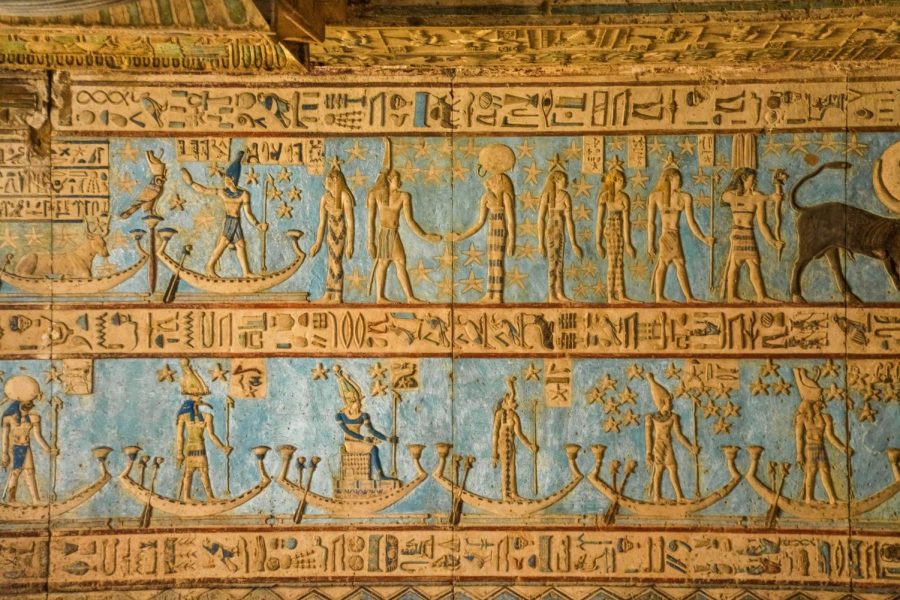A deeper look at three pantheons
Photo by Jeremy Bezanger on Unsplash
Myths were originally oral stories , preserved as pictographs.
If you’re an avid Rick Riordan fan, then your brain is likely stuffed with facts on Greek, Roman, and Egyptian mythology. I know mine is. If it isn’t, fret not, I am here to give you a crash course on these three pantheons because it’s fun to learn new things and you become more cultured.
I’m starting with the Greek pantheon since it’s what I’m the most familiar with, and you probably are, too. In Greek mythology, it is believed that the world began when Gaia (Mother Earth personified), Uranus (the sky personified), and the primordials spontaneously sprung from Chaos (nothingness). Gaia birthed the Titans, Cyclopses, and the Hecatoncheires (giants with a hundred arms and fifty heads). Uranus threw the latter in Tartarus because he was so disgusted with them.
Kronos, one of Gaia and Uranus’s Titan children, overthrew his father with his mother’s help. Aphrodite came into existence from Uranus’s remains getting thrown into the ocean. Kronos and Rhea, his sister and wife, had Hestia, Demeter, Hera, Zeus, Poseidon, and Hades together. Kronos swallowed each of his children except Zeus who Rhea hid from him to prevent a prophecy from coming true. Zeus rescuing his siblings and overthrowing Kronos is known as the Titanomachy.
From there, Zeus divided the world among himself (the skies/heavens), Poseidon (oceans), and Hades (underworld). He established Mount Olympus from where the Twelve Olympians would rule. The Twelve Olympians include Zeus, Hera, Poseidon, Hephaestus, Demeter, Aphrodite, Ares, Artemis, Apollo, Athena, Hermes, and Hestia or Dionysus (it varies). Hades was excluded because he spent most of the time ruling the Underworld.
In Roman mythology, there aren’t many stories about the creation of the world. Instead, there are two myths about Rome’s creation. The first comes from Virgil’s Aeneid, which details the adventures of Aeneas, a Trojan warrior. The second is about Romulus and Remus, Aeneas’s descendants, and their role in founding Rome. In terms of gods, many of them were taken straight from Greek mythology and given these names: Zeus became Jupiter, Hera became Juno, Poseidon became Neptune, Hephaestus became Vulcan, Demeter became Ceres, Aphrodite became Venus, Ares became Mars, Artemis became Diana, Apollo remained Apollo, Athena became Minerva, Hermes became Mercury, Hestia became Vesta, Dionysus became Bacchus, and Hades became Pluto.
According to the ancient Egyptians, the world was an expanse of dark waters named Nun. It “was personified as four pairs of male and female deities. Each couple represented one of four principles that characterized Nun: hiddenness or invisibility, infinite water, straying or lack of direction, and darkness or lack of light.” (https://bit.ly/3s1rtWW ) Atum, who created the humans and gods, created himself from the Nun through sheer will. Some Egyptian deities are Thoth (the god of knowledge), Osiris (god of the underworld), Isis (the goddess of motherhood, magic, and healing), Horus (god of war, a sky god, and sometimes worshipped as a sun god), Set (god of chaos, storms, and deserts), Ra (king of gods and sun god), Hathor (goddess of motherhood and fertility), Bastet (goddess of cats, the home, and protection), and Anubis (god of afterlife and mummification).
There are several ancient cultures that have detailed pantheons, and many of them are studied in the Mythology class offered in G-10. Juniors are encouraged to consider the class for their English option when the counselors visit this spring.

“For a second, I was thinking that I might write 5 articles this time. Then I reminded myself that I'm weak and can't handle it.”
Maya Nneoma Adimora...



